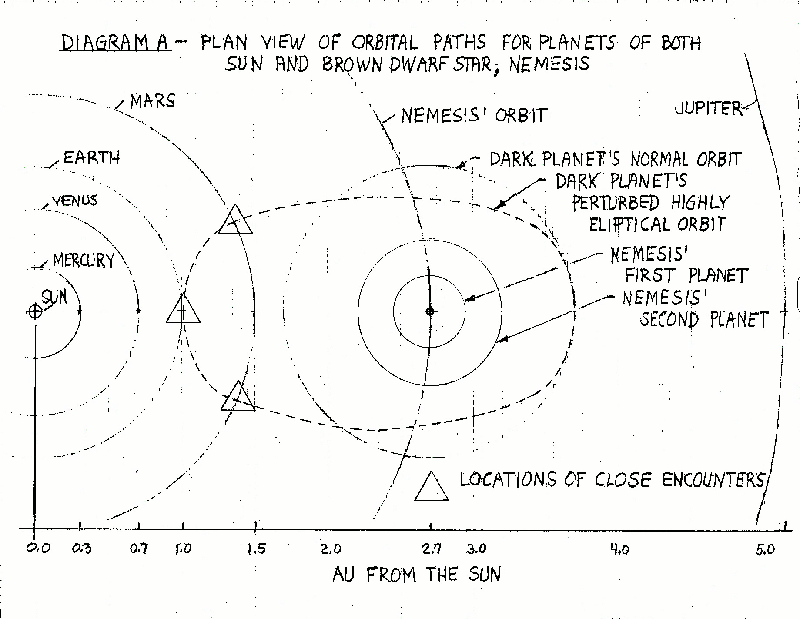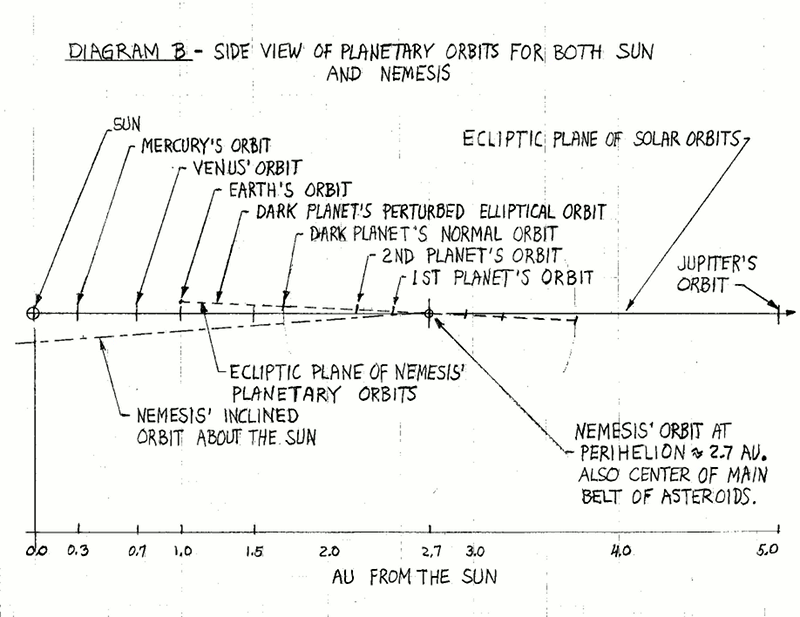Determining Slippage of Earth's Mantle
© spaceshiprider, DeveloperThe following paper is 1.88 MB; I will copy it to this submission. Any commentary or criticism is appreciated.Posted by Douglas Ettinger on 06/05/2014A Brief History of Mankind's Chaotic Past - Post-Paleolithic Times (20,000 Years Ago) to the Present - AddendaAddendum #1; Calculations Supporting the Proposal for a Slippage or Displacement of the Earth's Mantle (Calculations in Process)The author of this paper previously presented calculations in another paper to show how a large Martian-size body impacted the Earth causing its 23° axial tilt of its spin axis to the ecliptic plane. These non-computerized calculations used numerous assumptions and classical physics. This time a new set of calculations are presented in similar manner to show how both mechanics and electromagnetic forces partially rotated the Earth's mantle during an entirely different and much more recent event. The Earth's spin axis, less some temporary small wobble, and its orbital trajectory were unaffected. The proposal claims that the mantle was displaced latitudinally by about 15° to 20° with respect to the much heavier, gyroscopic-like, inner core which preserves the spin axis and interior magnetic field direction. Currently, the magnetic pole at 14° from the spin axis represents the residual magnetism in the mantle and lithosphere prior to the mantle shift 11,500 years ago. Both measured magnetic poles are slowly drifting toward the spin axis poles as would be expected. The residual magnetic field lines are slowly aligning with the active magnetic field lines that are parallel to the core's spin axis The Earth's core spins faster than the mantle and acts like a dynamo producing electricity and a resulting dipole magnetic field.This displacement of the Earth's mantle was responsible for ending the geological period called the Younger Dryas, for the Great Flood myth or real event known worldwide by many different cultural groups, for the mass extinction of numerous fauna, and supposedly, for the destruction of mankind's already well developed civilizations. Many other types of geological and biological data marked this well- defined catastrophic event. Different causes have been theorized such as quickly changing ocean currents, asteroid impact on the ice cap, and eruptions of mega-volcanoes, but none provide either a reason for the quick deaths of so many fauna in the northern latitudes and for global flooding. No real trigger or direct cause has ever been identified and or popularized. The flood myths via man's verbalizations and records of some of the epics from the first languages of ancient cultures reveal celestial events as the precursor or real cause.The proposal of this paper continues in stating that a close encounter of some celestial body caused this mantle displacement both by tidal accelerations and electromagnetic forces. This concept answers the important questions as to what might have triggered such a total global event 11,500 years ago to occur so quickly; what could have caused comets and other debris falling from the sky; what caused the earthquakes, volcanism, and severe weather – so severe as to cause the rapid freezing of large fauna; and what electromagnetic process caused the reversal and changing location of the magnetic poles. All these calamities occurred at the same time along with global flooding because the mantle and crust were displaced moving Siberia farther north and North America farther south. The geoid of Earth's crust had to adjust to new altitude changes thus causing the run-off of water from vast inland seas and lakes.The proposed celestial intruder is one of the planets orbiting the Nemesis star that returns every "Sar" cycle or every 3600 years. Since Nemesis is on an inclined orbit to the ecliptic plane, any of its orbiting planets can occasionally past closely overhead the Earth's northern pole during a period of months while Nemesis passes through the Sun's inner planetary system in about 12 years. Nemesis is believed to be a highly magnetic and highly charged brown dwarf star. Its corona or anode glow is very extensive and envelops its orbiting planetary system thereby transferring electrical charge and magnetism. These planets continue to store this increasing charge almost like one half of a capacitor waiting to discharge to the opposite plate or another close body with opposite charge. This paper's proposal continues to state that one of Nemesis' anodic charged planets discharged highly energetic plasma and current directly to Earth's closest surface, the northern polar region, in the form of Birkland current columns. This process is much like the Earth receiving charged particles from the Sun's solar wind thus creating auroras, except the incoming current is more than a factor of ten to a hundred of what is received from solar flares.The Birkland currents intercept the Earth's oceans and lithosphere and increase current line strength on the outside of the mantle as the increased current flow travels to the opposite pole. The salty sea water makes an excellent conductor of current. These stronger currents in turn increase the magnetism of the overall mantle. Hence, an increased interaction of magnetic forces is created between the passing magnetic Nemesis-planet and the Earth's magnetized mantle.The incoming Birkland currents also pass through the Earth's mantle parallel to outgoing current from the Earth's dynamo at the core. This increased current flow in turn increases the magnetic field strength of the mantle interior at the Polar Regions. Thus, the magnetic fields of both the passing planet and the Earth's mantle become interlocked. As the Nemesis-planet moves farther away its larger magnetic field strength pulls at the Earth's magnetic mantle trying to rotate it about the core.The interface surfaces between the outer liquid core and the bottom of the mantle can move with respect to each other, if the mantle receives forces to retard or change its motion. The interface between the liquid core and the solid core has motion differential that provides heat energy and the Earth's dynamo properties for creating its own magnetic field. The very dense and heavy solid inner core along with the outer liquid core gives the planet gyroscopic stability even though it has freedom in all three directions. This core is like a gyroscopic rotor that maintains its spin axis direction regardless of the orientation of the outer frame or the Earth's mantle.But, the liquid core can act like a fluid coupling that uses spheroidal motion instead of toroidal motion as occurs in an automobile drive transmission. If the mantle is acted on by some external force especially near the surface, the resultant torque can move the mantle latitudinally. The motion is stopped when the mantle's inputted angular velocity cross-section begins to match the upper liquid core's angular velocity cross-section. Normally, the stability of alignment between the outer liquid core and the mantle is maintained by both the conservation of angular momentum and the magnetic attraction of the underside of the mantle to the liquid core.If the magnetic field lines of force are suddenly broken at the mantle-core interface at the same time torque is applied to the mantle, then motion between this interface can occur causing the mantle to rotate with respect to the spinning core's axis. This is the process or mechanism that caused a brief but catastrophic mantle displacement. Some extra tidal acceleration occurs between the two planets but is insignificant in causing this slippage of the Earth's mantle. This particular celestial event is especially dominated by electromagnetic instead of gravitational forces.As the passing Nemesis-planet moves onward farther from the Earth's North Pole the Birkland column currents become distorted and pull on the mantle and then finally disconnect violently via plasma z-pinches. The mantle springs back causing an impulse-type torque within the magnetic circuit. The disconnection of the Birkland currents stops the magnetic field lines of force from holding and aligning the mantle to the outer liquid core. Hence, violent movement of the Earth's mantle occurs possibly over a short period of 6 hours for about 20° of mantle movement with respect to the spin axis. The weaker magnetic circuit of the Earth's dynamo is then re-established and fluid braking occurs after the rebound torque stops. The motion of the mantle with respect to the core then slowly stops.The Earth's lithosphere now must make the necessary adjustments in re-locating the colder polar temperatures and ice caps, in rapidly changing climates and ocean currents at lower latitudes, and in changing the geoid or oblateness of the Earth's crust that causes global flooding, earthquakes and volcanism. After the violent sea and lake run-offs stabilize, then, the ice caps that moved to lower latitudes begin to melt thereby pulsing and increasing the ever rising sea level of that interstadial period.This brief storyline gives us more assumptions to utilize in developing the following calculations. Some of these assumptions may have to be modified in order to achieve the best result or connection between what actually occurred. The desired result is stated, "The Earth's mantle is displaced about 20° of Earth's latitude from the existing North Pole very suddenly."Refer to Diagrams A and B for plan and side views of the orbital paths of both the Nemesis brown dwarf star's and the Sun's planets. The crossing orbital paths are postulated when Nemesis is at its perihelion or closest approach to the Sun. The diagrams are drawn roughly to scale using the unit of AU. If it is assumed that the expected orbits for Nemesis' planetary system do not exceed about 1 AU. In that case, no close intersection or crossing of orbits with the Sun's inners planets should occur. However, if the postulated "Dark Planet" or Nemesis' largest and most outer planet becomes perturbed, its new orbit may become elongated enough to cross Mars' orbit and come very close to Earth's orbit. Naturally, for that rare close encounter to occur Mars or Earth would have to be fairly close to the "Dark Planet's" crossing. That coincidental meeting is highly improbable but is possible over thousands of orbital crossings.The diagrams do not show the possible close encounters that could occur with the Nemesis-star system as it crosses the orbital paths of the outer planets: Jupiter, Saturn, Uranus, Neptune, and their satellites. The large red spot on Jupiter, the ring systems around most to the outer planets, the inclined spin axes, captured satellites in various inclined and irregular elliptical orbits, and the appearance of satellite surfaces being affected by high energy electric arcing all indicate the possible effects of some close encounter with the electrified and highly magnetic Nemesis system.Very close but rare encounters between the solar outer planets and the outer "Dark Planet" of Nemesis could easily perturb that planet's orbit into a more elongated elliptical and more inclined orbit. As shown in the diagrams this postulated perturbed orbit could then cross some of the inner-planet orbits. One or more close encounters are required with an outer planet for orbital perturbation. Then a following close encounter is required at the crossing of orbits within the inner solar system. These events are highly improbable but possible if one accounts for the statistical nature of how many events are involved. An orbital period of 3600 years for Nemesis divided into the age of the solar system of 4.5 billion years is 1-¼ million events. Other factors are also involved that can initiate the occurrence of close encounters such as the incalculable interaction of numerous gravity and intense electromagnetic fields.© Developer, spaceshiprider © Developer, spaceshiprider
© Developer, spaceshiprider










